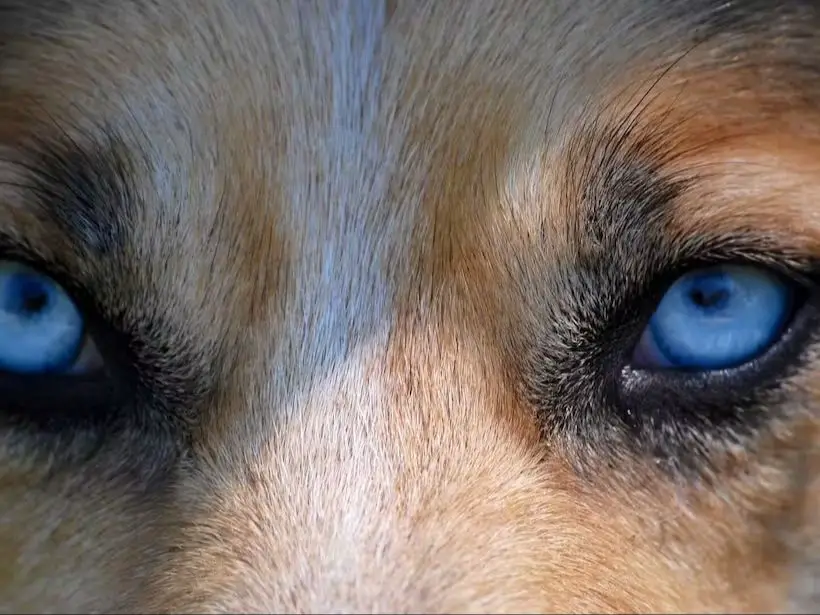Introduction
Blue eyes in dogs have long been thought to be connected to blindness and other health issues. This eye color is unusual in dogs and often raises concerns among owners. In this article, we’ll explore what causes blue eyes in dogs, look at any links between blue eyes and blindness, and discuss how to care for dogs with vision issues.
Blue eyes occur in dogs when there is a lack of pigmentation in the iris. This is controlled by a gene that is recessive, meaning two copies of the gene must be present for the blue eye color to appear. While some breeds like Siberian Huskies and Border Collies are known for their stunning blue eyes, the color is rarer in most dogs.
There has been speculation over whether blue-eyed dogs are more prone to health problems, especially issues with vision and blindness. We’ll analyze the current research to find out if there is any truth to this belief.
Understanding the genetics behind blue eyes and the real risks for vision loss can help owners provide the best care for their blue-eyed pups. Keep reading to learn more.
What Causes Blue Eyes in Dogs
The iris of a dog’s eye contains pigment that gives the eye its color. Brown eyes are caused by a large amount of pigment, while blue eyes result from a lack of pigment. Specifically, a lack of melanin (the brown pigment) within the iris causes the light to scatter and gives eyes a blue color.

The gene responsible for producing melanin is called SLC24A5. Dogs that inherit two copies of the variant form of this gene (one from each parent) are unable to produce melanin and will have blue eyes. This is common in breeds like Siberian Huskies and Border Collies.
Dogs can also develop blue eyes later in life if the iris loses its pigment due to injury or disease. Conditions like nuclear sclerosis, glaucoma, and corneal dystrophy can cause a dog’s eyes to turn blue when the tissue in the eye deteriorates.
In some cases, a dog can be born with one brown eye and one blue eye. This is called heterochromia and results when the melanin isn’t deposited properly during development in the womb.
References:
[1] https://www.wisdompanel.com/en-us/blog/blue-eyes-in-dogs
Common Blue-Eyed Dog Breeds
Blue eyes are not uncommon in dogs, and many different breeds exhibit this eye color. Some of the most common blue-eyed dog breeds include:
Siberian Huskies [1] often have striking blue eyes, sometimes in combination with brown eyes (complete heterochromia). Blue or split-blue eyes are considered a breed standard for Siberian Huskies.
Australian Shepherds [2] frequently have blue eyes as well as marbling, flecks, and mixed coloring. The breed standard allows for full blue, blue marbled with brown, or split blue and brown eyes.
Dalmatians [1] are often born with blue eyes that may darken over time. Blue eyes are accepted by the breed standard.
Border Collies [2] commonly exhibit blue eyes, which complement their black-and-white coats. The blue eye gene is inherited separately in Border Collies.
Other breeds like Weimaraners, Cardigan Welsh Corgis, Dachshunds, and Great Danes can also have blue eyes.
Is There a Link Between Blue Eyes and Blindness?
While blue eyes may seem closely associated with blindness in some breeds, there is no direct link between blue eyes themselves and eventual blindness in dogs. Blue eyes are caused by a lack of pigment in the iris, which is a physically separate part of the eye from the retina and optic nerve that allow for vision. Therefore, blue eyes alone do not directly impact a dog’s sight.
However, some genetic factors that cause blue eyes may also increase the risk for other vision defects like progressive retinal atrophy, cataracts, or glaucoma. So blue eyes can sometimes signal an underlying predisposition for eye disease, especially in breeds where blue eyes are uncommon. But blue eyes themselves do not inevitably lead to blindness.

Many dogs with blue eyes like Siberian Huskies enjoy excellent vision throughout their lives. Responsible breeders screen breeding dogs for genetic diseases to avoid perpetuating vision problems. With proper care and veterinary monitoring, most blue-eyed dogs can live full, healthy lives with no vision impairment. So blue eyes are not a definite predictor of blindness, though extra attention to eye health may be warranted for some blue-eyed breeds.
Sources:
https://dogcare.dailypuppy.com/blueeyed-dogs-blind-sooner-6213.html
Conditions That Cause Blue Eyes and Blindness
While blue eyes themselves do not directly cause blindness in dogs, there are some conditions that can result in both blue eyes and vision problems:
Optic nerve hypoplasia is one condition where underdevelopment of the optic nerve leads to small, pale blue eyes from birth. Dogs with this condition often have severely impaired vision or blindness. It is seen more often in certain breeds like Border Collies, Australian Shepherds, and Great Danes.
Persistent pupillary membranes are strands of fetal remnant tissue in the eye that fail to regress as normal after birth. They can cause blue discoloration of the pupil and are associated with various ocular defects like cataracts, glaucoma, and retinal dysplasia that impact vision. This condition is seen in breeds like Weimaraners, Doberman Pinschers, and Golden Retrievers.
Cataracts, or cloudiness in the lens of the eye, can turn an affected dog’s eyes a blue-gray color later in life. Cataracts disrupt focusing of light in the eye and cause blurred vision, glare, and blindness if left untreated. Cataracts are common in diabetic dogs and breeds like Siberian Huskies and Poodles.
While these conditions can result in blue eyes and blindness, it does not mean all dogs with blue eyes will necessarily develop vision problems. Regular eye exams by a veterinarian are important for the early diagnosis and treatment of conditions that could impact your dog’s eyesight.
Other Causes of Blindness in Dogs
There are several other common conditions that can cause blindness or vision loss in dogs, including:
Cataracts
Cataracts are an opacity or cloudiness that develops in the lens of the eye, causing blurred vision. Cataracts are one of the most common causes of blindness in dogs, especially in older dogs. They can develop from aging, diabetes, eye injuries, inflammation, or genetics. Cataract surgery may be recommended to restore vision if the cataracts are advanced enough to significantly impair sight (Source).
Glaucoma
Glaucoma is a condition where pressure builds up inside the eye, damaging the optic nerve. It is often inherited in certain breeds like Beagles, Cocker Spaniels, and Basset Hounds. Glaucoma causes gradual vision loss and blindness if untreated. Medications, surgery, or both may be used to treat glaucoma in dogs (Source).
Progressive Retinal Atrophy
Progressive retinal atrophy (PRA) is a group of genetic diseases that cause degeneration of the retina over time, leading to declining vision and eventual blindness. PRA is common in breeds like Labrador and Golden Retrievers, Collies, Mastiffs, and Samoyeds. There is no cure for PRA, but steps can be taken to slow vision loss (Source).
Signs Your Dog May Be Going Blind
There are a few telltale signs that your dog’s vision may be deteriorating. Be on the lookout for the following:
- Clumsiness – Dogs rely heavily on sight to navigate their surroundings. You may notice your dog bumping into furniture, walls, or other objects that they previously avoided. Stumbling on stairs or reluctance to jump up or down from furniture can also be an indicator of vision loss.
- Hesitant on stairs – Dogs with impaired vision often become increasingly hesitant or fearful of stairs. They may pace at the bottom or top of stairs or need encouragement to ascend or descend stairs they previously managed with ease.
- Poor night vision – Dim lighting and darkness present challenges for dogs losing their sight. You may notice your dog being more anxious, clingy or reactive at night. They may also have difficulty finding treats or toys in low light situations.
While many senior dogs gradually lose vision due to age-related degeneration, sudden vision changes should always be evaluated by a veterinarian. They can test your dog’s eyes and determine if medical treatment is available for the cause of blindness.
Cite: https://www.akc.org/expert-advice/health/vision-loss-in-dogs/

Caring for a Blind Dog
One of the most challenging aspects of caring for a blind dog is helping them navigate through the home and outdoors safely. Here are some tips on assisting blind dogs:
Create a consistent routine with set feeding times, walk times, etc. This helps the dog better understand what to expect throughout the day without sight (1). Keep furniture in the same position so the dog can memorize the layout. Rearrange carefully and gradually if needed (2).
Use mats, rugs, and runners on hard floors to help the dog’s paws grip. Provide stair steps or ramps to help the dog access couches, beds or vehicles. Install textured surfaces on outdoor steps (3).
Keep pathways clutter-free inside and outside. Pick up objects like shoes and cords. Remove low-hanging or dangerous branches outside. Consider fencing off hazards like pools and staircases (1).
Use scents, sounds, and textures to guide your dog. Placing scented oils on furniture legs or door frames helps your dog understand their location. Hang wind chimes or place bells on doors to alert the dog. Place different textured rugs in front of exterior doors vs interior doors (2).
Use verbal cues consistently during walks and daily activities. For example, say “step up” when approaching stairs or “slow down” when nearing an obstacle. A guide harness designed for blind dogs can also help provide directional assistance (1).
With patience and the proper adjustments, blind dogs can live happy lives in their homes. Consult with your veterinarian for more tips on caring for a blind pet.
(1) https://www.humanesociety.org/resources/how-care-blind-pets
(2) https://www.rspca.org.uk/-/blog-livingwithblinddogs
(3) https://www.care.com/c/17-tips-for-living-with-a-blind-dog/
Summary
In summary, while some dogs are born with naturally occurring blue eyes, the blue eye color by itself does not mean a dog will go blind. There are some genetic conditions like microphthalmia that can cause both blue eyes and blindness in dogs. However, blue eyes alone are not an indication that a dog will have vision problems.
Some dog breeds, like the Siberian Husky, are predisposed to inheriting blue eyes, but most go on to live normal lives with no vision issues. Blindness in dogs can also be caused by other eye diseases like cataracts or progressive retinal atrophy, as well as injuries, toxicity, infections, or aging – none of which are related to blue eyes.
If you notice any vision problems in your blue-eyed dog, it’s important to see your veterinarian right away. With early detection and treatment, there are many ways to manage and slow the progression of blindness to help dogs live full, happy lives.

References
Mayo Clinic Staff. “Disorders of the retina.” Mayo Clinic. https://www.mayoclinic.org/diseases-conditions/retinal-disorders/symptoms-causes/syc-20352444. Accessed [date].
Miklosi, Adam. “Why Are Some Dogs’ Eyes Blue?” Psychology Today. https://www.psychologytoday.com/us/blog/why-dogs-do-what-they-do/201407/why-are-some-dogs-eyes-blue. Accessed [date].
Nelson, Sara. “Blindness in Dogs.” PetMD. https://www.petmd.com/dog/conditions/eyes/c_dg_blindness. Accessed [date].
Tandon, Ruchi, et al. “Merle Gene: Beautiful Coat Color with Blindness.” International Journal of Livestock Research, vol. 3, no. 1, 2013, pp. 16-25.
Sawyer, Sarah. “Why Do Some Dogs Have Blue Eyes?” American Kennel Club. https://www.akc.org/expert-advice/health/why-do-some-dogs-have-blue-eyes/. Accessed [date].
